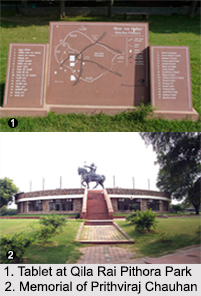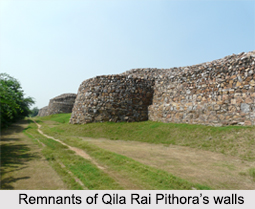 Qila Rai Pithora was the first fortified city in Delhi of the medieval era. Also known as Rai Pithora`s Fort, it was established in 12th century by Rajput ruler Prithviraj Chauhan, after the Chauhan Rajputs had taken over Delhi from the Tomar Rajputs. The Tomars are credited for having founded Delhi and ruler Anang Pal I in the 8th century constructed the first known regular defense structure Lal Kot. Lal Kot was captured by Prithviraj Chauhan who extended it to the city Qila Rai Pithora. The Chauhans and the Slave Dynasty ruled over Delhi from here, and its ramparts are visible across South Delhi in Saket, Mehrauli around Qutb complex, Kishangarh and Vasant Kunj areas. There is also a memorial of Prithviraj Chauhan on a horse.
Qila Rai Pithora was the first fortified city in Delhi of the medieval era. Also known as Rai Pithora`s Fort, it was established in 12th century by Rajput ruler Prithviraj Chauhan, after the Chauhan Rajputs had taken over Delhi from the Tomar Rajputs. The Tomars are credited for having founded Delhi and ruler Anang Pal I in the 8th century constructed the first known regular defense structure Lal Kot. Lal Kot was captured by Prithviraj Chauhan who extended it to the city Qila Rai Pithora. The Chauhans and the Slave Dynasty ruled over Delhi from here, and its ramparts are visible across South Delhi in Saket, Mehrauli around Qutb complex, Kishangarh and Vasant Kunj areas. There is also a memorial of Prithviraj Chauhan on a horse.
History of Qila Rai Pithora
In 1160 AD, ruler Prithviraj Chauhan took over Delhi from the Tomars, along with the fort city of Lal Kot, the first extant city of Delhi. Thereafter, Chauhan whose capital was Ajmer in Rajasthan, made extensive renovations to the Lal Kot citadel that had large rubble walls and ramparts, erecting massive ramparts around it and renaming it the Qila of Rai Pithora or Qila Rai Pithora. It was made into a 13-gate fortress complex extending to 6.5 kilometres, encompassing the city that existed with it while the older Lal Kot served as the walled citadel. The Qila Rai Pithora served the capital of the empires in North India for over 100 years.
However, the rule of the Chauhans didn`t last long when in the 1190s, the Afghans invaded. Though the Chauhans defeated Muhammad Ghori in the First Battle of Tarain in 1191, a year later in 1192, his general Qutb ud-din Aibak defeated Prithviraj Chauhan in the Second Battle of Tarain, ending their dynasty. Ghori made Qutb ud-din Aibak a Naib-us-Sultanat in India, who after Ghori"s death made himself the ruler of his kingdom. This established Muslim rule in India, with Aibak"s Mamluk or Slave dynasty, the first Sultanate of Delhi. However, Aibak did not extend or alter the fort structure and it remained same through his early successors as well.
Architecture of Qila Rai Pithora
Qutb ud-din Aibak built the Quwwat ul Islam Mosque, the first mosque to be established in Delhi and the world-renowned Qutb Minar in the city of Qila Rai Pithora. The architecture of the mosque is a fusion of Hindu and Islamic tradition, since local Hindu sculptors were employed in its construction.
Decline of Qila Rai Pithora
The Khilji Dynasty took over from the Mamluks in late 13th century and shifted the capital to the new and well-fortified city Siri, approximately 6 kilometres from Qila Rai Pithora to better defend themselves from Mongol invasions.



















